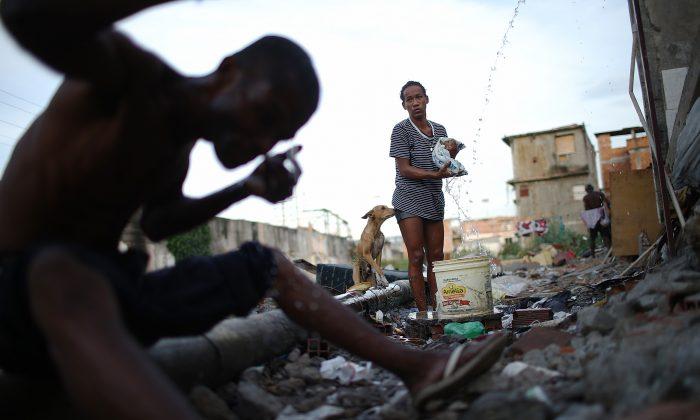RIO DE JANEIRO – It was supposed to be the “Copa Verde,” a celebration of the greenest World Cup ever, in the country that’s home to the Amazon, ranked first in biodiversity, vital to how the world responds to climate change.
Instead, the “Green Cup” has become a flash point for social injustice. And while it’s proving environmentally unsustainable on several levels, the lasting legacy of the 2014 World Cup may ultimately be a shift in how future global sporting events are marketed and built.
Since the 2000 Olympic Games in Sydney, most international sporting “mega-events” have tried to market themselves as environmentally sustainable. But various scholars and sustainability experts agree that none of these events – with their massive carbon footprints and huge infrastructure needs – have lived up to that claim in the long term.
Is the goal realistic? Other priorities often shunt aside green promises.
That’s certainly the case in Brazil: The economy is sputtering, Brazilians are furious at the bill for the costliest World Cup ever, corruption allegations are flying and public services like health, education, housing and transportation are in decline. Environmental impacts are near the bottom of a long list of grievances.
Sustainability Benchmarks
That’s not to say mega-events can’t have an impact. The 2006 World Cup in Germany strived to be carbon neutral. Tickets for matches could also be used on public transportation systems. Some stadiums had solar power, rainwater collection cisterns and free bicycle parking. Meanwhile, analyses of the 2008 Beijing Olympics credit the games with advancing environmental technologies and speeding up some national environmental reforms. And the 2012 London Olympics got praise for strengthening sustainability benchmarks, focusing on strategies that future mega-events could adopt.
More difficult has been moving sustainability efforts beyond the arena. And the public’s expectations for sustainability in these large-scale events are expanding. Today they include not only carbon emissions, pollution controls and recycling but social justice considerations.
No mega-event to date has highlighted that as prominently as this year’s World Cup. Yet longterm sustainability remains elusive.
“The forms of development that have occurred in Brazil in connection with the World Cup and the Olympic Games are not what most people would describe as sustainable in physical or social terms,” said Jay Coakley, a professor emeritus of sociology from the University of Colorado at Colorado Springs who has studied sustainability in sporting events.
Secondary to Food, Housing, Education
Sports mega-events have become so costly for host cities and countries that few resources are left for dealing with the needs of poor and working class communities they affect, Coakley said. “Sustainability becomes secondary to food, housing, medical care, education and basic public transportation.”
FIFA, the international governing body of soccer that organizes the World Cup, announced its sustainability strategy two years ago at the United Nations Conference on Sustainable Development in Rio de Janeiro (RIO+20). It included LEED green building certification for stadiums, Brazil-based carbon offsets, recycling and water conservation measures.
But the protests about the Cup that have swept Brazil underscore the dissonance between FIFA’s commitments to a green, environmentally sustainable event and the public outcry over the lack of lasting social investment.
“Environmental issues were totally absent from the protests,” said Fabián Echegaray, founder of Market Analysis, a Brazil-based market research company that specializes in sustainability.
Limited to 12 Stadiums
Echegaray thinks FIFA’s emissions offset plan and green design features were legitimate accomplishments. The problem, he noted, is that FIFA laid out a green agenda that was largely restricted to the 12 stadiums across the country where the games will be played.
Everything else – from the air travel emissions to reliance on gas-fueled taxis for airport transfer and movement around cities in the absence of a well-functioning public transportation system – runs counter to even the most traditional sustainability criteria. The lack of significant investment in basic public infrastructure prompted, in part, the public outcry.
That’s not to say that the connection between environmental and social sustainability has been off FIFA’s radar. Alongside energy-efficiency measures, carbon offsets and waste recycling systems, FIFA touts the creation of social programs in the communities where the matches will be held.
But Graeme Hayes, a professor of politics and sociology at Aston University in England, doubts whether these efforts can produce the kind of longterm benefits that a more inclusive definition of sustainability would require.
2012 London Olympics
The 2012 London Olympics has been down this road. Organizers promised the first truly sustainable summer games, featuring not only carbon offsetting and green technology features, but a plan to address East London housing needs, social diversity and community involvement.
The carbon accounting was rigorous, said Hayes, who studied London 2012’s sustainability effort. But the games fell short of reaching the broader social goals.
“You look at London two years later and say what has changed? What effect has it had overall on British society and in relation to what’s environmentally and not environmentally sustainable?” Hayes asked. “You'd have to say that the results are negligible.”
‘Shock and Awe’
Approaches to sustainability in these mega-events, Hayes added, tend to be more about organizers and social elites staging a “shock-and-awe” vision that dazzles audiences but doesn’t solve longstanding social challenges.
In Brazil, examples abound:
- FIFA celebrated solar panels, water conservation and waste reduction features at a new $420 million stadium in São Paulo and the $500 million renovation at Rio’s legendary Maracanã stadium. Meanwhile, residents were evicted from some of Rio’s favela slums and 5,000 squatters set up a camp near the arena in São Paulo to protest the city’s lack of affordable housing.
- The deadline for completing the first line of a monorail between São Paulo suburbs, to convey visitors smoothly from the airport while reducing pollution and traffic congestion, was pushed back amid construction delays. Further lines are planned, but without a clear timetable.
- The new LEED-certified stadium in Manaus, deep in the Amazon, features the latest in energy-efficient heating and cooling systems. But plans for powering the stadium completely with solar energy had to be abandoned amid construction delays. Meanwhile irked Brazilians question the cost – $300 million – of building an enormous stadium in a remote city that may never again see such a large event.
But the sporting industry does have leverage to shift entire markets to green, said Allen Hershkowitz, a senior scientist at the Natural Resources Defense Council, who has worked with many sports leagues and co-founded the Green Sports Alliance.
Shifting the Global Supply Chain
“We’ve got the plastic, energy, textile, transportation, chemical industries involved, so when professional sports embraces environmental stewardship, it really informs a global supply chain.”
And it’s about more than just the concrete reductions made in carbon emissions, waste or water usage, Hershkowitz added. Sport can influence public opinion – and even government action – around climate change and environmental sustainability in ways that science and policy debates cannot, he said.
“Scientists are not necessarily the greatest presenters. But people really pay attention to sports.”
Hershkowitz believes the green sports movement has the potential to be one of the most influential in the history of environmentalism. But when NRDC received a request to work with Brazil on its World Cup sustainability goals, the organization declined.
‘Totality of the Impacts’
Hershkowitz said there was no way to assure the legitimacy of the environmental claims, and preparations for the games seemed fraught with social justice challenges.
“You’ve got to look at the totality of the impacts, not just the material and structural,” he said. “We’ve seen billions of dollars of investment, a very visible endeavor. It’s an area to advance ecologically preferable technologies, but also [to ensure that] issues of equality and social justice are part of sustainability goals.”
In Brazil, it wasn’t clear that could happen. “The World Cup is a lost opportunity,” he said.
But in its failure, the 2014 World Cup could have a lasting impact on sustainability after all.
Hayes thinks the image of people taking to the streets in this soccer-obsessed country will endure as the attention shifts to future mega-events, notably 2022 World Cup host Qatar, already facing criticism for exploitative labor practices and its carbon footprint.
It will be citizens, however, not FIFA and the International Olympic Committee, pushing for social justice and sustainability to become a more meaningful part of future event planning, Hayes said.
“Brazil is a really big thing because it has a legitimacy in the world of football as being the home of the beautiful game, the home of football,” he said.
“Brazil saying ‘we don’t want this’ is going to cause really big shockwaves.”
Republished with permission from DailyClimate.org. Read the original.



Friends Read Free